| This article is missing information about 1953-53 monetization mentioned at 2011 United States debt-ceiling crisis § Monetizing gold. Please expand the article to include this information. Further details may exist on the talk page. (May 2023) |
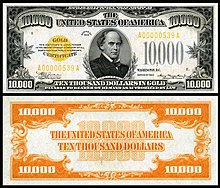
Gold certificates were issued by the United States Treasury as a form of representative money from 1865 to 1933. While the United States observed a gold standard, the certificates offered a more convenient way to pay in gold than the use of coins. General public ownership of gold certificates was outlawed in 1933 and since then they have been available only to the Federal Reserve Banks, with book-entry certificates replacing the paper form.
Overview
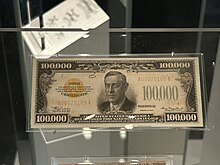
Gold certificates were first authorized under the Legal Tender Act of 1863, but unlike the United States Notes also authorized, they apparently were not printed until 1865. The need for them arose from the limitations of the United States Notes. To promote the flow of gold into the Treasury and maintain the credit of the government, the notes could not be used to pay customs duties or interest on the federal debt. Gold certificates, representing coins held physically in the Treasury, were instead provided for those purposes. The notes, as legal tender for most purposes, were the dominant paper currency until 1879 but were accepted at a discount in comparison to the gold certificates. After 1879 the government started to redeem United States Notes at face value in gold, bringing them into parity with gold certificates and making the latter also a candidate for general circulation.
The first gold certificates had no series date; they were hand-dated and payable either to the bearer or to the order of a named payee. They featured a vignette of an eagle uniformly across all denominations. Later issues (series 1870, 1871, and 1875) featured portraits of historical figures. The reverse sides were either blank or featured abstract designs. The only exception was the $20 of 1865, which had a picture of a $20 gold coin. The Series of 1882 was the first series that was uniformly payable to the bearer; it was transferable and anyone could redeem it for the equivalent in gold. This was the case with all gold certificate series from that point on, with the exception of 1888, 1900, and 1934. The series of 1888 and 1900 were issued to specific payees as before. The series of 1882 had the same portraits as the series of 1875, but a different back design, featuring a series of eagles, as well as complex border work.
Historic U.S. gold certificates (1863–1933)
Gold certificates, along with all other U.S. currency, were made in two sizes—a larger size from 1865 to 1928, and a smaller size beginning with the series of 1928. The backs of all large-sized notes (and also the small-sized notes of the Series of 1934) were orange, resulting in the nickname "yellow boys" or "goldbacks". The backs of the Series of 1928 bills were green, and identical to the corresponding denomination of the more familiar Federal Reserve Notes, including the usual buildings on the $10 through $100 designs and the less-known abstract designs of denominations $500 and up. Both large and small size gold certificates feature a gold treasury seal on the obverse, just as U.S. Notes feature a red seal, silver certificates (except World War II Hawaii and North Africa notes) a blue seal, and Federal Reserve Notes a green seal.
In the case of the Series 1928 (small-size) gold certificates, they bore a redemption statement with the following text: "This certifies that there have been deposited in the Treasury of the United States of America XXXXX Dollars in Gold Coin payable to the bearer on demand."
Series of 1900 $10,000 Gold Certificates
Another interesting note is the Series of 1900. Along with the $5,000 and $10,000 of the Series of 1888, all 1900 bills ($10,000 denomination only) have been redeemed, and no longer have legal tender status. Most were destroyed, with the exception of a number of 1900 $10,000 bills that were in a box in a post office near the U.S. Treasury in Washington, D.C. There was a fire on December 13, 1935, and employees threw burning boxes out into the street. The box of canceled high-denomination currency burst open. Much to everyone's dismay, they were worthless. There are several hundred outstanding, and their ownership is technically illegal, as they are stolen property. However, due to their lack of intrinsic value, the government has not prosecuted any owners, citing more important concerns. They carry a collector value in the numismatic market and, as noted in Bowers and Sundman's The 100 Greatest American Currency Notes, the only United States notes that can be purchased for less than their face value. This is the only example of "circulating" U.S. currency that is not an obligation of the government, and thus not redeemable by a Federal Reserve Bank. The note bears the portrait of Andrew Jackson and has no printed design on its reverse side.
End of the Gold Certificate Era in the United States (March 1933)
As part of the Roosevelt Administration's response to the effects of the Great Depression and particularly the outflow of gold for hoarding and for shipment overseas, the practice of redeeming gold certificates for gold coin was ended by Presidential Proclamation 2039 (dated March 6, 1933) and Executive Order 6073 (dated March 10, 1933). On April 5, 1933, Executive Order 6102 was issued; it required all persons in the United States to deliver (with limited exceptions) all gold coin, gold bullion, and gold certificates to the Federal Reserve by May 1, 1933. By order of the Secretary of the Treasury dated December 28, 1933, private possession of gold certificates was declared illegal. Due to their (then-) illegal status and public fear that the notes would be devalued and made obsolete, this resulted in the majority of circulating notes being retired.
The restrictions on private ownership of gold certificates were revoked by Treasury Secretary Douglas Dillon effective April 24, 1964, primarily to allow collectors to own examples legally; however, gold certificates are no longer redeemable for gold, but instead can be exchanged at face value for other U.S. coin and currency designated as legal tender (e.g., Federal Reserve Notes and United States Notes). In general, the notes are scarce and valuable, especially examples in "new" condition.
Series of 1934 Gold Certificates; Modern usage by the Federal Reserve System
The Gold Reserve Act of 1934 established a new accounting mechanism, through the issue of a special series of gold certificates, to account for gold held by the Federal Reserve Banks on behalf of the United States. The Secretary of the Treasury is authorized to "prescribe the form and denominations of the certificates".
The Series of 1934 (bearing the signatures of William Alexander Julian (Treasurer) and Henry Morgenthau (Treasury Secretary)) consisted of the following denominations: $100; $1,000; and $10,000 (mirroring the circulating Federal Reserve Notes of the same series and denominations). However, there was also a $100,000 denomination (bearing the portrait of President Woodrow Wilson) that had no equivalent in other types of U.S. currency and was also the largest currency denomination ever issued by the United States Treasury. 42,000 of the $100,000 denomination were printed. According to the Bureau of Engraving and Printing's own website, the $100,000 certificates were printed between December 18, 1934, and January 9, 1935. These notes were never intended for circulation in the general economy and there are no known instances of any such certificates ever being released outside government channels, other than as specimens such as one recently graded by PMG.
Reflecting the purpose for which these certificates were issued, the redemption statement on their face was changed to read as follows: "This certifies that there is on deposit in the Treasury of the United States of America XXXXX Dollars in Gold payable to bearer on demand as authorized by law."
Since the 1960s, most of the paper certificates have been destroyed, and the currently prescribed form of the "certificates" issued to the Federal Reserve is an electronic book entry account between the Federal Reserve and the Treasury. The electronic book entry system also allows for the various regional Federal Reserve Banks to exchange certificate balances among themselves. However, the Treasury authorized a small amount of them to be retained at certain Federal Reserve Banks (where they had been used) for educational and historical purposes, such as being placed on public display. In addition, a $100,000 Series of 1934 gold certificate is part of the numismatic collection at the Smithsonian's National Museum of American History.
As of December 2013 the Federal Reserve reported holding $11.037 billion (face value) of these certificates. The Treasury backs these certificates by holding an equivalent amount of gold at the statutory exchange rate of $42 2/9 per troy ounce of gold, though the Federal Reserve does not have the right to exchange the certificates for gold. As the certificates are denominated in dollars rather than in a set weight of gold, any change in the statutory exchange rate towards the (much higher) market rate would result in a windfall accounting gain for the Treasury.
Series and varieties
| Series | Value | Features/varieties |
|---|---|---|
| 1865
|
|
Notes from this first issue are extremely rare in lower ($20 and $100) denominations. A single $1,000 and $5,000 are reported to exist in a government collection, and an issued $500 or $10,000 has never been seen. In addition to the two engraved signatures customary on United States banknotes (the Register of the Treasury and Treasurer of the United States), the earlier issues of Gold certificates (i.e., 1865, 1870, 1875, and some 1882) included a third signature of one of the Assistant Treasurers of the United States (in New York or Washington, D.C.). Known as a countersigned or triple-signature note, this feature existed for all Series prior to 1882 (and the first printing of the Series 1882). |
| 1870–75 |
|
Series 1870 notes introduced portraits to gold certificates. Both Series of 1870 and Series of 1875 are countersigned notes. Between the two series, the $100 is extremely rare, the $500, $1,000, and $10,000 are unique (in government collections), and the $5,000 is unknown. |
| 1882 |
|
The Act of July 12, 1882, authorized denominations "not less than $20". |
| 1888 |
|
Series 1888 notes were intended for bank use to balance accounts without having to transport large volumes of gold bullion or currency. They have all been redeemed. |
| 1900 | $10,000 | Canceled -- Not legal tender. Several hundred notes exist and examples occasionally appear for sale. See above. |
| 1905 | $20 | |
| 1906 | $20 | |
| 1907 |
|
|
| 1913 | $50 | |
| 1922 |
|
Complete United States gold certificate type set
Large
| Value | Issue | Series | Fr. | Image | Portrait | Signature & seal varieties |
|---|---|---|---|---|---|---|
| 20$20 | 1st | 1865 | Fr.1166b | Image pending | Vignettes of eagle with shield | 1166b – Colby and Spinner – small red |
| 100$100 | 1st | 1865 | Fr.1166c | 
|
Vignette of eagle with shield | 1166c – Colby and Spinner – small red |
| 500$500 | 1st | 1865 | Fr.1166d proof |
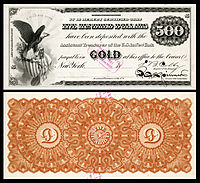
|
Vignette of eagle with shield | 1166d – Colby and Spinner – small red |
| 1000$1,000 | 1st | 1865 | Fr.1166e proof |
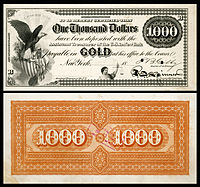
|
Vignettes of eagle with shield, and justice with scales. | 1166e – Colby and Spinner – small red |
| 5000$5,000 | 1st | 1865 | Fr.1166f proof |
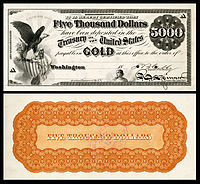
|
Vignettes of eagle with shield and female | 1166f – Colby and Spinner – small red |
| 10000$10,000 | 1st | 1865 | Fr.1166g proof |

|
Vignettes of eagle with shield | 1166g – Colby and Spinner – small red |
| 100$100 | 2nd & 3rd | 1870–75 | Fr.1166h | 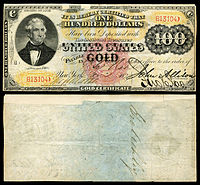
|
Thomas Hart Benton | 1166h – xxx and xxx – large red (1870) 1166m – Allison and New – large red (1875) |
| 500$500 | 2nd & 3rd | 1870–75 | Fr.1166i | 
|
Abraham Lincoln | 1166i – Allison and Tuttle – large red (1870) 1166n – Allison and New – large red (1875) |
| 1000$1,000 | 2nd & 3rd | 1870–75 | Fr.1166j proof |

|
Alexander Hamilton | 1166j – xxx and xxx – large red (1870) 1166o – Allison and New – large red (1875) |
| 5000$5,000 | 2nd & 3rd | 1870–75 | Fr.1166k proof |

|
James Madison | 1166k – Allison and Gilfillan – large red |
| 10000$10,000 | 2nd & 3rd | 1870–75 | Fr.1166l proof |

|
Andrew Jackson | 1166l – xxx and xxx – large red (1870) 1166q – Allison and Wyman – large red (1875) |
| 10$10 | 7th | 1907 | Fr.1172 | 
|
Michael Hillegas | 1167 – 1172
1167 – Vernon and Treat – Gold |
| 10$10 | 9th | 1922 | Fr.1173 | 
|
Michael Hillegas | 1173 – Speelman and White – Gold 1173a – Speelman and White – Gold, small serial numbers |
| 20$20 | 4th | 1882 | Fr.1175a | 
|
James Garfield | 1174 – 1178
1174 – Bruce and Gilfillan – brown |
| 20$20 | 4th | 1882 | Fr.1177 | 
|
James Garfield | |
| 20$20 | 7th | 1905 | Fr.1180 | 
|
George Washington | 1179 – Lyons and Roberts – small red 1180 – Lyons and Treat – small red |
| 20$20 | 7th | 1906 | Fr.1185 | 
|
George Washington | 1181 – 1186
1181 – Vernon and Treat – Gold |
| 20$20 | 9th | 1922 | Fr.1187 | 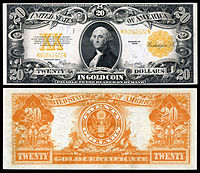
|
George Washington | 1187 – Speelman and White – Gold |
| 50$50 | 4th | 1882 | Fr.1189a | 
|
Silas Wright | 1188 – 1197
1188 – Bruce and Gilfillan – brown |
| 50$50 | 4th | 1882 | Fr.1195 | 
|
Silas Wright | |
| 50$50 | 9th | 1913 | Fr.1199 | 
|
Ulysses S. Grant | 1198 – Parker and Burke – Gold 1199 – Teehee and Burke – Gold |
| 50$50 | 9th | 1922 | Fr.1200a | 
|
Ulysses S. Grant | 1200 – Speelman and White – Gold 1200a – Speelman and White – Gold, small serial numbers |
| 100$100 | 4th | 1882 | Fr.1202 | 
|
Thomas Hart Benton | 1201 – 1214
1201 – Bruce and Gilfillan – brown |
| 100$100 | 4th | 1882 | Fr.1207 | 
|
Thomas Hart Benton | |
| 100$100 | 9th | 1922 | Fr.1215 | 
|
Thomas Hart Benton | 1215 – Speelman and White – small red |
| 500$500 | 4th | 1882 | Fr.1216a | 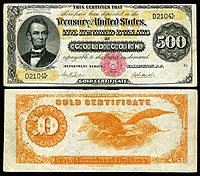
|
Abraham Lincoln | 1215a – 1216b
1215a – Bruce and Gilfillan – brown |
| 500$500 | 9th | 1922 | Fr.1217 | 
|
Abraham Lincoln | 1217 – Speelman and White – small red |
| 1000$1,000 | 4th | 1882 | Fr.1218a | 
|
Alexander Hamilton | 1218 – 1218g
1218 – Bruce and Gilfillan –brown |
| 1000$1,000 | 4th | 1882 | Fr.1218g | 
|
Alexander Hamilton | |
| 1000$1,000 | 8th | 1907 | Fr.1219 | 
|
Alexander Hamilton | 1219 – 1219e
1219 – Vernon and Treat – Gold |
| 1000$1,000 | 9th | 1922 | Fr.1220 | 
|
Alexander Hamilton | 1220 – Speelman and White – Gold |
| 5000$5,000 | 4th | 1882 | Fr.1221a proof |

|
James Madison | 1221 – 1221j
1221 – Bruce and Gilfillan – brown |
| 5000$5,000 | 5th | 1888 | Fr.1222a proof |

|
James Madison | 1222 – Rosecrans and Hyatt – large red 1222a – Rosecrans and Nebecker – small red |
| 10000$10,000 | 4th | 1882 | Fr.1223a proof |
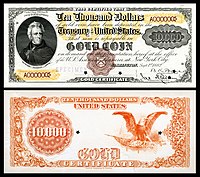
|
Andrew Jackson | 1223 – 1223g
1223 – Bruce and Gilfillan – brown |
| 10000$10,000 | 5th | 1888 | Fr.1224a proof |

|
Andrew Jackson | 1224 – Rosecrans and Hyatt – large red 1224a – Rosecrans and Nebecker – small red |
| 10000$10,000 | 6th | 1900 | Fr.1225 | 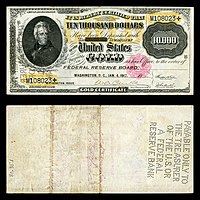
|
Andrew Jackson | 1225a – 1225h
1225a – Lyons and Roberts – small red |
Small
| Value | Series | Fr. | Image | Portrait | Signature & seal varieties |
|---|---|---|---|---|---|
| 10$10 | 19281928 | Fr.2400 | 
|
Alexander Hamilton | 2400 – Woods and Mellon – gold |
| 20$20 | 19281928 | Fr.2402 | 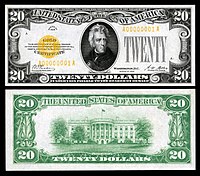
|
Andrew Jackson | 2402 – Woods and Mellon – gold |
| 50$50 | 19281928 | Fr.2404 | 
|
Ulysses Grant | 2404 – Woods and Mellon – gold |
| 100$100 | 19281928 | Fr.2405 | 
|
Benjamin Franklin | 2405 – Woods and Mellon – gold. |
| 500$500 | 19281928 | Fr.2407 | 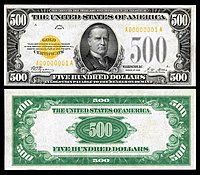
|
William McKinley | 2407 – Woods and Mellon – gold. |
| 1000$1,000 | 19281928 | Fr.2408 | 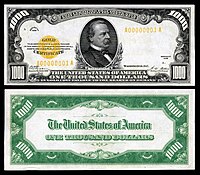
|
Grover Cleveland | 2408 – Woods and Mellon – gold. |
| 5000$5,000 | 19281928 | Fr.2410 | 
|
James Madison | 2410 – Woods and Mellon – gold. |
| 10000$10,000 | 19281928 | Fr.2411 | 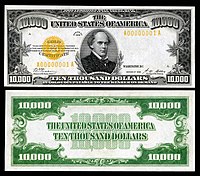
|
Salmon P. Chase | 2411 – Woods and Mellon – gold. |
| 100$100 | 19341934 | Fr.2406 | 
|
Benjamin Franklin | 2406 – Julian and Morgenthau – gold. |
| 1000$1,000 | 19341934 | Fr.2409 | 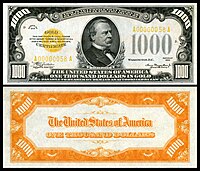
|
Grover Cleveland | 2409 – Julian and Morgenthau – gold. |
| 10000$10,000 | 19341934 | Fr.2412 | 
|
Salmon P. Chase | 2412 – Julian and Morgenthau – gold. |
| 100000$100,000 | 19341934 | Fr.2413 | 
|
Woodrow Wilson | 2413 – Julian and Morgenthau – gold. |
Series catalogue
This is a chart of some of the series of gold certificates printed. Each entry includes: series year, general description, and printing figures if available.
Small-size gold certificates
| Series | Denominations | Signatures | Printing Figure |
|---|---|---|---|
| 1928 | $10 | W. O. Woods – Andrew W. Mellon | 33,356,000 |
| 1928 | $20 | W. O. Woods – Andrew W. Mellon | 67,704,000 |
| 1928 | $50 | W. O. Woods – Andrew W. Mellon | 5,520,000 |
| 1928 | $100 | W. O. Woods – Andrew W. Mellon | 3,240,000 |
| 1928A | $100 | W. O. Woods – Ogden L. Mills | 120,000* |
| 1934 | $100 | W. A. Julian – Henry Morgenthau Jr. | 120,000* |
| 1928 | $500 | W. O. Woods – Andrew W. Mellon | 420,000 |
| 1928 | $1,000 | W. O. Woods – Andrew W. Mellon | 288,000 |
| 1934 | $1,000 | W. A. Julian – Henry Morgenthau Jr. | 84,000* |
| 1928 | $5,000 | W. O. Woods – Andrew W. Mellon | 24,000 |
| 1928 | $10,000 | W. O. Woods – Andrew W. Mellon | 48,000 |
| 1934 | $10,000 | W. A. Julian – Henry Morgenthau Jr. | 36,000* |
| 1934 | $100,000 | W. A. Julian – Henry Morgenthau Jr. | 42,000* |
* Notes: All Series 1928A gold certificates were consigned to destruction and never released; none are known to exist.
See also
Footnotes
- Notes issued under a given Series (e.g., Series 1882, Series 1907) are, in some cases, released over a period of years, as reflected in the Friedberg number signature and seal varieties. For example, based on dates of the signature combinations, the Series 1907 $10 gold certificate was first issued with the signature combination of Vernon and Treat (in office together from 1906 to 1909) and last issued with the Teehee and Burke signatures (in office together from 1915 to 1919). Therefore, a Series 1907 note could have been issued as late as 1919.
- There was a massive fire in a new Post Office building at the corner of 12th and Pennsylvania, in Washington D.C., on Friday, December 13, 1935. At the time, part of the 6th floor was being used for Treasury Department storage. Fire Fighters threw many boxes of documents out of the windows and into the streets below. One such box contained almost every surviving piece of the series 1900 Gold Certificates. Passersby quickly grabbed them up off the street, although all of the notes had been previously redeemed and canceled. Treasury records indicate that there are no outstanding redeemable notes of this series.
Notes
- Morgenthau, Henry (Jr.) (December 28, 1933). "Secretary of the Treasury Gold Order, December 28, 1933". FRASER (https://fraser.stlouisfed.org). Press Releases of the United States Department of the Treasury : Volume 11. Federal Reserve Bank of St. Louis. Retrieved March 14, 2022.
{{cite journal}}: External link in|website= - Dillon, Douglas (April 24, 1964). "29 FR 5556, "Removal of Delivery Requirements for Gold Certificates and General License to Hold Gold Certificates"" (PDF). GovInfo.gov (https://www.govinfo.gov). Office of the Federal Register. Retrieved March 14, 2022.
{{cite web}}: External link in|website= - "Chapter 31, United States Code". Retrieved March 31, 2013.
- "Denominations Above The $100 Note". Bureau of Engraving and Printing. Retrieved March 16, 2022.
- "PMG Certifies Seldom-seen $100,000 US Gold Certificate Specimen." August 18, 2020. Pmgnotes.com.
- "CUSTODY OF GOLD CERTIFICATES, SERIES OF 1934, as specified by the United States Treasury". Archived from the original on August 2, 2022. Retrieved February 22, 2014.
- "ISSUE AND REDEMPTION OF GOLD CERTIFICATES, as specified by the United States Treasury". Archived from the original on August 2, 2022. Retrieved February 21, 2014.
- "GOLD CERTIFICATE ACCOUNT, as Specified by Federal Reserve System". Retrieved February 21, 2014.
- "100,000 Dollars, Gold Certificate, United States, 1934". National Museum of American History. Retrieved March 16, 2022.
- "Federal Reserve H.4.1 Release". Retrieved December 28, 2013.
- Friedberg & Friedberg, pp. 164–173.
- Friedberg & Friedberg, p. 303.
- ^ Friedberg & Friedberg, 2013, p. 165.
- Blake, p. 19.
- Waldron, George B. (1896). A Handbook on Currency and Wealth: With Numerous Table and Diagrams. Funk & Wagnallis Company. p. 20. Retrieved July 6, 2014.
- The Bankers' Magazine. 43: 813. 1888.
{{cite journal}}: Missing or empty|title=(help) - Friedberg & Friedberg, 2013, pp. 172-173.
- Friedberg & Friedberg, 2013, p. 173.
- "USPaperMoney.Info". Retrieved December 9, 2011.
References
- Friedberg, Arthur L.; Friedberg, Ira S. (2013). Paper Money of the United States: A Complete Illustrated Guide With Valuations (20th ed.). Coin & Currency Institute. ISBN 978-0-87184-520-7. Retrieved February 14, 2014.
| Obsolete United States currency and coinage | |||
|---|---|---|---|
| Topics | |||
| Coins |
| ||
| Currency | |||
| Related | |||